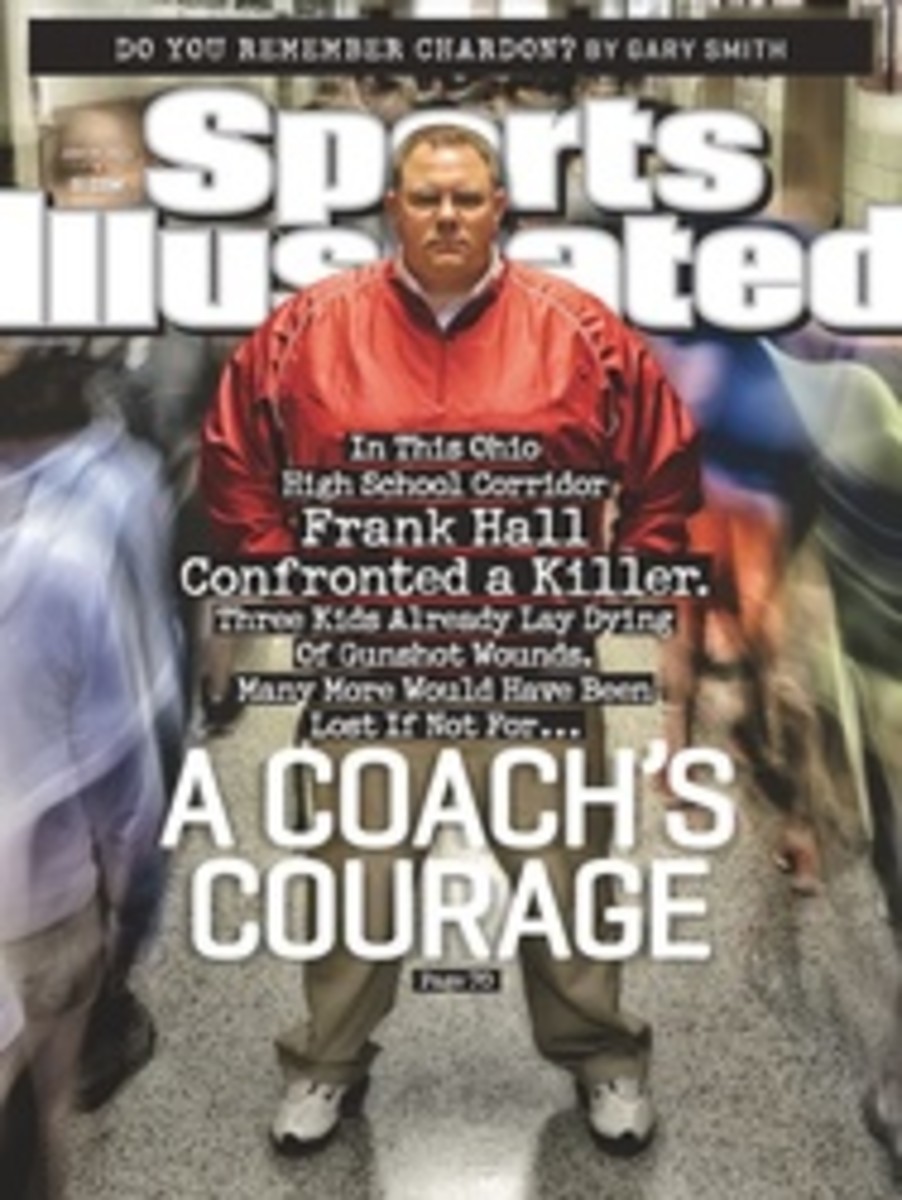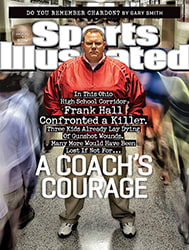
OLD-SCHOOL CHAMPION
We're starving. Not for food. Oh, no. We stop for a slice at the first stomach rumble and follow it with six ounces of fro-yo because we can. No, what we hunger for is dirt. Hogan's driving-range dirt is the first thing that comes to mind, but anything from God's green earth will do. We want grass, wind, rain. We want a racing heart from climbing a hill too fast, eager to see the view from beyond the crest. We want some solid thing that will last, that has no motherboard, that we can deposit in our memory bank, like the smell of a childhood beach.
And into this vast chasm of desire, who should enter after a 32-year disappearance from U.S. Open fun? Merion, the old gal herself, site of national championship number 113, with her sweeping hills and rocky outcroppings. The sprawling white clubhouse is the very picture of gentility. Phil's exposure to the elements left him wet (Thursday), wind-burned (Saturday) and both (Sunday). The rough was long, the creek was high, the tees were back (a few crazily), the pins were tucked (a few crazily), but what the hell, it was the same for everybody. Merion, bless her curvy soul, held up. Turns out, we spent all that time worrying for nothing. Isn't that often the case?
Really, she more than held up. Even Mike Davis, a golfing savant in the area of course setup, was surprised by the scoring. The USGA executive director told his fellow Far Hillers that he did not see this coming, a winning score over par. And that was with soft greens that never dried out, with fairways that were nearer to mushy than firm, on a course short enough that it could be played without a driver, even if Luke Donald hit driver on the par-3 3rd on Sunday, 266 yards, up the hill. (Phil Mickelson carried a 64-degree wedge instead of a driver.) Justin Rose's winning score was one over par, on a course that measured 6,996 yards at its longest.
The USGA likes to say it does not care about, quote, defending par. "I absolutely don't believe that," Bill Walsh, a 91-year-old lion of Philadelphia golf, said on U.S. Open Sunday, while marshaling the 13th hole. He first came to Merion in the early 1940s as a caddie. "It's the U.S. Open! As good as these players are? It's terrific that par holds up. It's vindicating!"
The various combatants, 156 of them, ranging in age from 18 to 54, came to the par-70 course, wielding titanium, their fast-twitch muscles all twitchy underneath their "technical fabric" golf shirts. A euphemism for polyester, no doubt, but who really cares: 281 strokes for four rounds of golf last week got you—that is, Justin Rose—the trophy and a check for $1.4 million, just as 280 strokes, in the 1971 U.S. Open at Merion, got Lee Trevino and Jack Nicklaus spots in an 18-hole playoff, which Trevino won. He pocketed $30,000.
That's the equivalent of $172,000 today, and Trevino, of course, won in '71 with persimmon woods and steel shafts and balata balls and other museum pieces. In '81 David Graham won with the same stuff. If you want to make the case that everything's changed in the game over the past 32 years, the stage is yours.
But Merion showed that where it counts most, nothing has changed, and the scoreboard totals are an illustration of that. The goal, to take the fewest strokes over four rounds, and the challenge, to transmit the intent from head to ball, has not changed and will not change. Rose surely hit shots last week that Trevino could never have imagined. The Englishman did not, however, have a thought or an emotion the Merry Mex did not know. The game is the game. Thank you, Merion, for reminding us of that all over again.
Why were the scores so high? The greens (weirdly canted). The fairways (narrow, seldom level). The bunkers (unusually deep). The rough (wet and long). The hole locations (often three yards off the collars). The shape of the holes (often curved). The modern ball (flies far, curves little). The wind (four days of at least a mild blow). The occasion (title sponsor: the United States of America).
On Tuesday night there was a clubhouse dinner for U.S. Open champions. Johnny Miller started crying as he talked about what the national championship meant to him. Trevino talked about his old girlfriend, the one who lives on Ardmore Avenue. Arnold Palmer talked about his only national championship, at Cherry Hills in 1960. He has a much lesser career without it, and he knows it. Phil came to Merion with five runners-up and now has six. It's inconceivable that any other tournament could produce such a record.
Merion held up as Fenway holds up, as Yosemite holds up, as Catcher in the Rye holds up. Now sitting in with the Preservation Hall Jazz Band, a lady who needs no surname, the one, the only, Miss Merion! Nicklaus and his fellow World Golf Hall of Famer Nick Price had the whole thing figured out years ago. Nicklaus has been saying for decades that the ball needs to be slowed down, and had the governing bodies listened to him, Merion would not have needed a bunch of new tees and new bunkers.
Price, at the dawn of the Tiger era, had another take. To test the best players in the world, to bunch the fields, to diminish the importance of überlength, you go to a shorter course, not a longer one. You grow rough, you narrow the fairways, you take water off the greens. Aside from the dry greens, that was Merion, a mere 6,869 yards for the Sunday finale. Merion, drenched by one rainstorm after another all spring and into the tournament itself, never got dry. She could have played way hard.
Warning: Do not take that word, hard, to heart. Hard is good for the world's best players, not for us. The unfortunate legacy of the Masters is that emerald green has become the official color of American golf, when it should be closer to brown. American golf-course operators, supers, chairwomen of greens committees and anybody else within earshot: Do not take your cues from Merion. She was manipulated with unholy amounts of seed and water and fertilizer and manpower to get the exact result we all enjoyed watching. The pros could play last week only because there were caddies and spectators and marshals to find their many errant shots. (No prominent player lost a ball. Of course, it's easier to find your ball on a 111-acre site than on a more typical one, 220 acres.) The 85 shooter really will go to Merion and shoot 103. Do you want to shoot 103? A nice time to be invited to Merion is November, when the rough has started to go dormant for winter. They don't play the U.S. Open in November.
Mike Davis was asked on Sunday night if the USGA would like to return to Merion for a U.S. Open. "From our side, absolutely," he said, pointing out that the USGA responds to invitations from clubs. The members would surely want another Open, once they get over the stress of this 2013 tournament. When several inches of rain was falling on the Monday before the tournament, you could see members falling into a state of despair. There was something tender about it, these accomplished, successful individuals faced with something they could not control: the weather. The success of the Open at Merion should be a signal to other old-line clubs with shaped holes that they can still challenge the best players in the world wielding their hot balls and hot clubs. The Country Club in Brookline, Cypress Point Club, Chicago Golf Club, Newport Country Club, several of the Bandon Dunes courses, what are you waiting for? Here's a start: Mr. Mike Davis, USGA, Box 708, Far Hills, N.J. 07931.
More than any other elite private club, Merion has a public face. A public road bisects the course. Merion has now hosted more USGA championships, 18, than any other club, which means, on average, every few years the public is invited in again to walk her hills and get to know her quirks. No player played more practice rounds at Merion than Justin Rose, and no player appreciated Merion's English pedigree more than Justin Rose. English means blind shots, drivable par-4s and undrivable par-3s, 6,900 yards that, in the elements and under the conditions, is more than you could ever want.
Rose played his final approach shot from just beyond the Hogan plaque, marking the spot from which Ben struck his famous one-iron in 1950. Rose hit a four-iron over the green. He was asked to compare his 281 with Trevino's 280. "I just put one foot in front of another," he said. "Trevino was a great hitter of the golf ball. He kept the ball in front of him all the time. And that's obviously what pays off at the U.S. Open. He probably hit many fairways, many greens and didn't try to do anything too special. I don't exactly know how he went about it, but I can only imagine that it was good, solid golf. To win a tournament at 280 or 281, it means you're playing a tough test. There's no other way to win than just play good, solid golf."
In Philadelphia, solid is high praise. The guy's solid. We were craving something solid, and we got it. A solid player on a solid course made solid scores for four straight days: 71, 69, 71, 70. There's nothing there to tweet, but that picture of Rose playing that final approach shot from behind the plaque is lodged in your head, isn't it?
Merion, bless her curvy soul, held up. Turns out, we spent all that time worrying for nothing.
The challenge, to transmit the intent from head to ball, has not changed and will not change.
"There's no other way to win than just play good, solid golf," Rose said of contending in the Open.
GOLF MAGAZINE
TOP 100 TEACHERS POLL
What is the best U.S. Open venue?
MERION 42%
OAKMONT 21%
PEBBLE BEACH 37%
Two respondents questioned why Shinnecock Hills and Bethpage Black weren't on the list.
PHOTO
Photograph by SIMON BRUTY/SPORTS ILLUSTRATED
THE HARD TRUTH Playing as long as 254 yards, the par-3 17th hole ranked as the seventh-toughest hole at Merion. It yielded only 22 birdies over the four days, but on Sunday, Shawn Stefani became the first player to produce an ace at the club during a U.S. Open.
PHOTO
FRED VUICH FOR SPORTS ILLUSTRATED (UMBRELLAS)
WET AND WILD Torrential rains softened the course, but they couldn't dampen the spirits of golf fans, who crammed into the 111-acre venue.
PHOTO
ROBERT BECK/SPORTS ILLUSTRATED (WOODS)
TIGER TAMED With a 13-over-par 293 total, Woods had his highest score in 62 major starts as a professional.
PHOTO
FRED VUICH FOR SPORTS ILLUSTRATED
ROUGH START Mickelson ran into trouble at the par-4 5th on Sunday, making double bogey on a hole that played to a stroke average of 4.706.
PHOTO
ROBERT BECK/SPORTS ILLUSTRATED
JUSTIN TIME Rose didn't shoot lower than 69, but his even-par round on Sunday was more than four shots better than the average for the field.

